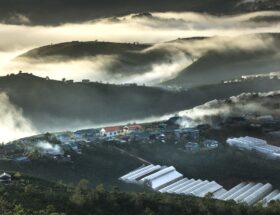
Coffee Production 101: From Farm to Cup
Do you start your day with a cup of coffee? If so, have you ever wondered about the journey that little coffee bean takes before it reaches your cup? Coffee production is a fascinating process that involves multiple steps and countless hours of hard work. Join us in this blog post as we explore the journey of coffee from the farm to your cup.
In this blog post, we will dive into the fascinating world of coffee production, taking you on a journey from the farm where coffee beans are grown to the cup where the delicious brew is savored. Along the way, we’ll explore the different stages of coffee production, from cultivation and harvesting to processing and roasting. By the end, you’ll have a deeper understanding and appreciation for the intricate process behind your favorite cup of joe.
Table of Contents
- The Journey Begins: From Farm to Cup
- Supporting Evidence and Examples
- Frequently Asked Questions
- 1. How is coffee produced?
- 2. What are the different types of coffee beans?
- 3. How does the origin of coffee affect its taste?
- 4. What is the best way to store coffee beans?
- 5. How should I brew coffee for the best results?
- 6. Is coffee production sustainable?
- 7. How does the coffee industry impact local communities?
- Conclusion
The Journey Begins: From Farm to Cup
When it comes to our daily cup of joe, have you ever wondered about the fascinating journey behind it? Coffee production involves several meticulous steps, starting from the farm and culminating in our mugs. Let’s embark on a coffee-filled adventure as we explore the process from farm to cup.
1. Harvesting the Cherries
The coffee journey begins on lush plantations worldwide, where skilled farmers carefully cultivate coffee trees, nurturing them until the cherries are ripe for picking. This crucial step requires expertise and precision, as only the ripest cherries are harvested.
2. Processing Methods
Once the cherries are harvested, they undergo different processing methods, each unique and yielding varying flavor profiles. The two primary methods are:
- Dry Processing: In this traditional method, the cherries are spread out to dry naturally in the sun. This process enhances the coffee’s body and imparts earthy flavors.
- Wet Processing: Alternatively, the cherries can undergo wet processing. Here, they are pulped and fermented, removing the fruit before being dried. This approach maintains acidity and yields a cleaner taste.
3. Roasting and Grinding
After processing, it’s time for the transformation of green coffee beans into aromatic, ready-to-brew beans. The beans are carefully roasted to perfection, using specific time and temperature combinations. This crucial step unlocks the beans’ flavors and aromas, with the duration of roasting determining whether it’s light, medium, or dark roast. The roasted beans are then meticulously ground, allowing for the extraction of the coffee’s full potential.
4. Brewing Methods
Finally, it’s time to brew our beloved coffee. From traditional drip machines to trendy pour-over methods and modern espresso machines, numerous brewing techniques exist to satisfy every coffee lover’s preferences. The choice of brewing method influences the taste, strength, and aroma of the final cup. Experimentation is key to finding your perfect brew!
The journey from coffee farm to our cups is a remarkable one, involving skilled farmers, meticulous processing, roasting expertise, and our personalized brewing techniques. Next time you take a sip of your favorite brew, take a moment to appreciate the intricate journey it has undertaken to bring you joy and a delightful coffee experience!
Supporting Evidence and Examples
Now that we understand the basics of coffee production, let’s delve deeper into the process and explore some supporting evidence and examples.
1. Sustainable Farming Practices
- A study conducted by the International Coffee Organization (ICO) found that coffee farms implementing sustainable farming practices not only contribute to environmental conservation but also yield higher quality beans.
- In Costa Rica, the Tarrazu region employs shade-grown coffee methods, which protect the coffee plants from harsh weather conditions and provide habitat for birds and other wildlife.
- By using organic fertilizers and pest control methods, farmers in Ethiopia ensure that their coffee beans are free from harmful chemicals, resulting in a healthier and more environmentally-friendly product.
2. Fair Trade Certification
In recent years, the fair trade movement has gained momentum within the coffee industry. Fair trade certification ensures that coffee farmers receive fair wages and work under decent conditions. Here are some examples:
- Through fair trade initiatives, farmers in Colombia have been able to build schools and healthcare facilities for their communities, improving their overall quality of life.
- A study conducted by the Fairtrade Foundation revealed that fair trade benefits small-scale coffee farmers in Guatemala, enabling them to invest in better farming equipment, leading to increased productivity and income.
3. Coffee Varieties
There are various coffee varieties grown around the world, each offering unique flavors and characteristics. Let’s explore a few examples:
- Ethiopian coffee, specifically the Ethiopian Sidamo variety, is known for its distinct floral and wine-like flavors, with hints of blueberry and chocolate.
- Colombian coffee, often made from the Arabica bean, is renowned for its mild and well-balanced flavors, making it a popular choice among coffee connoisseurs.
- Brazilian coffee, the largest coffee producer globally, is characterized by its nutty and chocolatey taste, making it ideal for espresso blends.
By presenting supporting evidence and examples, we can see the direct impact of sustainable farming practices, fair trade certification, and the wide range of coffee varieties on the overall coffee production process. These factors highlight the intricate journey from farm to cup and further enhance our appreciation for the world’s favorite caffeinated beverage.
Frequently Asked Questions
1. How is coffee produced?
Coffee production involves several steps, starting with the cultivation of coffee plants on farms. The ripe coffee cherries are then harvested and processed through methods like wet or dry processing. Next, the beans are dried, sorted, roasted, and finally ground for consumption. This is how is Coffee made.
2. What are the different types of coffee beans?
There are two main types of coffee beans: Arabica and Robusta. Arabica beans are known for their delicate flavor profiles, acidity, and aroma, while Robusta beans have a stronger, more bitter taste and higher caffeine content.
3. How does the origin of coffee affect its taste?
The origin of coffee plays a significant role in its taste. Factors like climate, altitude, soil composition, and cultivation methods vary from region to region, resulting in unique flavor profiles. Coffees from different countries and regions will showcase distinct characteristics and notes.
4. What is the best way to store coffee beans?
To maintain the freshness and flavor of coffee beans, store them in an airtight container in a cool, dark place. Avoid exposing them to light, heat, moisture, or strong odors that can compromise their quality. It is advisable to grind the beans just before brewing for the best taste.
5. How should I brew coffee for the best results?
For optimal brewing, use freshly ground coffee beans and clean, filtered water. The brewing method can vary depending on personal preference, but popular methods include pour-over, French press, espresso machines, or drip coffee makers. Experimentation with water-to-coffee ratios and brewing times can help tailor the taste to your liking.
6. Is coffee production sustainable?
Coffee production faces various sustainability challenges, including deforestation, water usage, and fair working conditions. However, many coffee producers and organizations are implementing sustainable practices such as shade-grown farming, water conservation, and fair trade initiatives to mitigate these issues.
7. How does the coffee industry impact local communities?
The coffee industry often plays a vital role in the economic development of coffee-growing regions. It provides employment opportunities, income generation, and supports local businesses. Additionally, some coffee producers engage in social initiatives, providing education, healthcare, and infrastructure development in their communities.
Conclusion
In this blog post, we delved into the fascinating journey of coffee production, from farm to cup. We explored how coffee is grown, harvested, processed, roasted, and brewed to create the perfect cup of joe.
We learned about the hard work and dedication that goes into coffee farming, highlighting the importance of sustainable practices and fair trade. The intricate process of processing and roasting coffee beans was demystified, shedding light on the various factors that contribute to the unique flavors and aromas we savor in our cups.
Transitioning to the brewing stage, we discussed different brewing methods, such as pour-over, french press, and espresso, each offering a distinct taste experience. We also explored the significance of a good grinder and fresh, quality beans in achieving a flavorful brew.
Throughout the post, we have emphasized the need for conscious consumption, supporting ethical and sustainable coffee production. By choosing coffee that is ethically sourced, we can make a positive impact on coffee farming communities and the environment.
Now armed with the knowledge of coffee production, it’s time to put it into action. Take a moment to reflect on your coffee choices and consider how you can support sustainable and fair trade practices. Try out new brewing techniques, experiment with different flavors, and share your newfound love for coffee with your friends and family.
We hope you enjoyed this journey into the world of coffee production. Don’t forget to share your thoughts and experiences in the comments below. Happy brewing!









